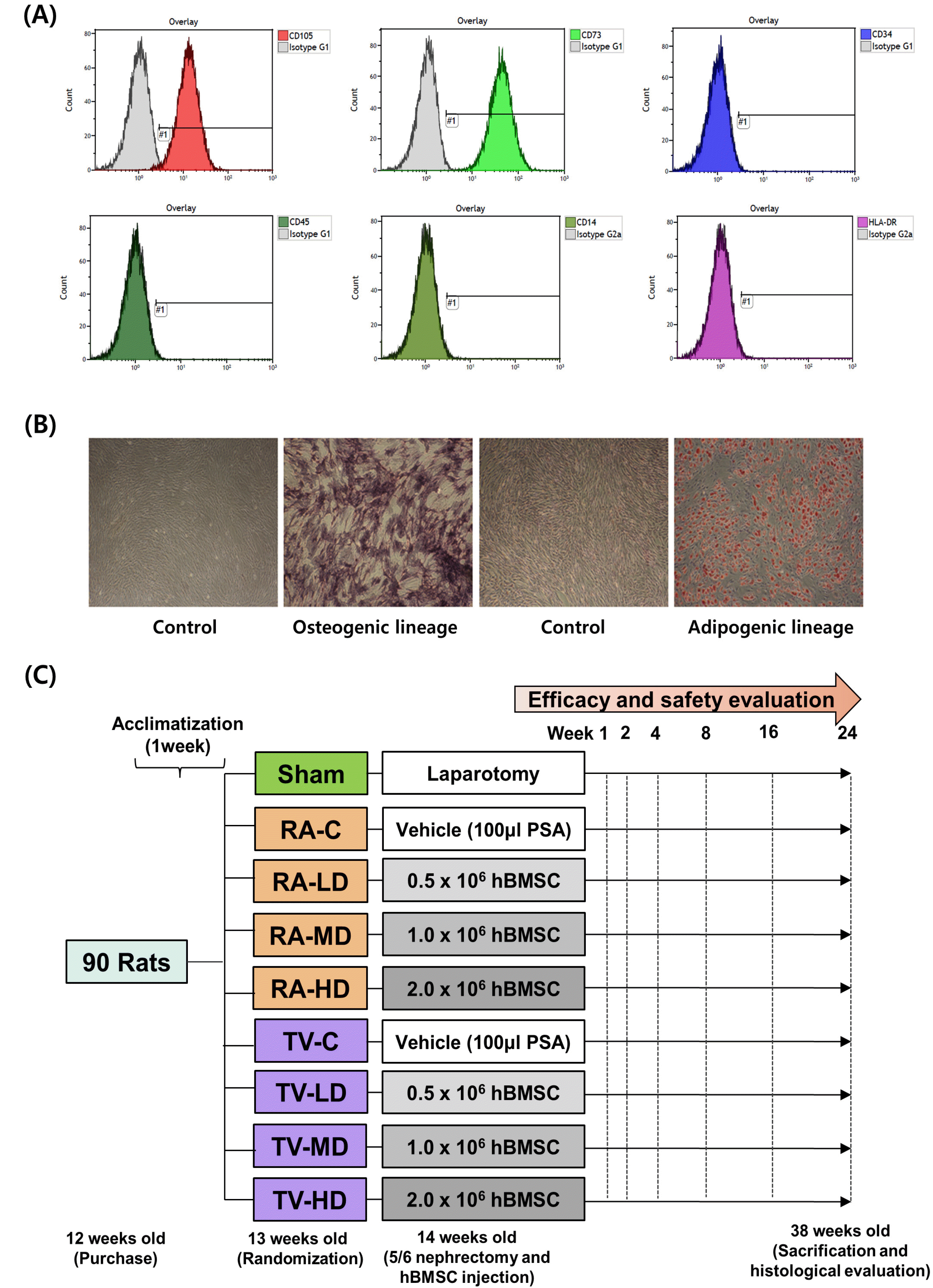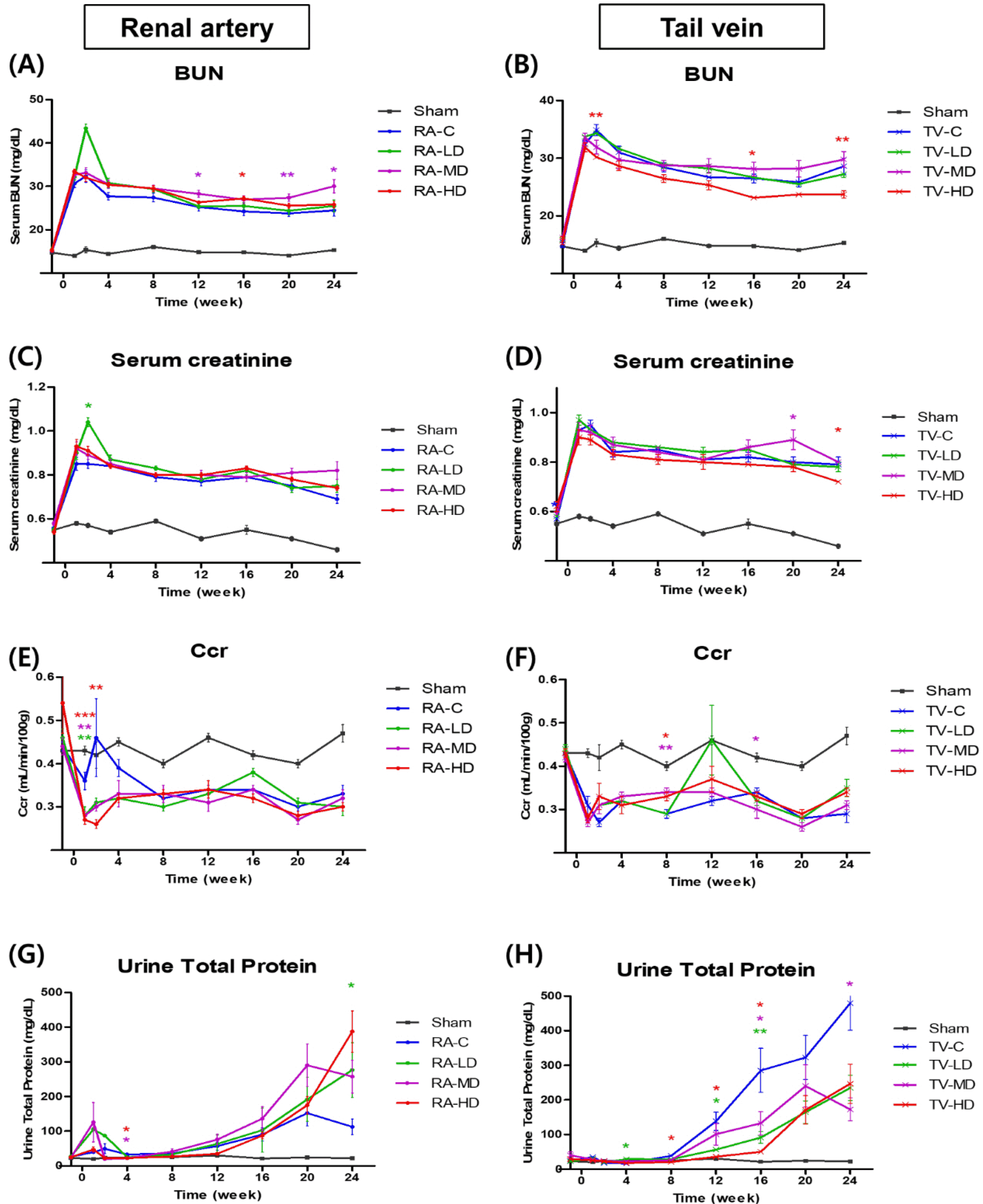1. Friedenstein AJ, Chailakhyan RK, Latsinik NV, Panasyuk AF, Keiliss-Borok IV. 1974; Stromal cells responsible for transferring the microenvironment of the hemopoietic tissues. cloning in vitro and retransplantation in vivo. Transplantation. 17:331–340. DOI:
10.1097/00007890-197404000-00001. PMID:
4150881.
3. Steinberg GK, Kondziolka D, Wechsler LR, Lunsford LD, Kim AS, Johnson JN, Bates D, Poggio G, Case C, McGrogan M, Yankee EW, Schwartz NE. 2018; Two-year safety and clinical outcomes in chronic ischemic stroke patients after implantation of modified bone marrow-derived mesenchymal stem cells (SB623): a phase 1/2a study. J Neurosurg. 131:1462–1472. DOI:
10.3171/2018.5.JNS173147. PMID:
30497166.
4. Reinders ME, Dreyer GJ, Bank JR, Roelofs H, Heidt S, Roelen DL, Zandvliet ML, Huurman VA, Fibbe WE, van Kooten C, Claas FH, Rabelink TJ, de Fijter JW. 2015; Safety of allogeneic bone marrow derived mesenchymal stromal cell therapy in renal transplant recipients: the neptune study. J Transl Med. 13:344. DOI:
10.1186/s12967-015-0700-0. PMID:
26537851. PMCID:
PMC4632480.
6. National Research Council Committee for the Update of the Guide for the Care and Use of Laboratory Animals. 2011. Guide for the care and use of laboratory animals. 8th ed. National Academies Press;Washington, D.C.:
7. Hamed GM, Morsy WE, Hamid MSA, Hassan AAEM, Zahra FAA. 2019; Effect of bone marrow-derived mesenchymal stem cells on ischaemic-reperfused hearts in adult rats with established chronic kidney disease. Int J Stem Cells. 12:304–314. DOI:
10.15283/ijsc18114. PMID:
31022998. PMCID:
PMC6657945.
8. Quevedo HC, Hatzistergos KE, Oskouei BN, Feigenbaum GS, Rodriguez JE, Valdes D, Pattany PM, Zambrano JP, Hu Q, McNiece I, Heldman AW, Hare JM. 2009; Allogeneic mesenchymal stem cells restore cardiac function in chronic ischemic cardiomyopathy via trilineage differentiating capacity. Proc Natl Acad Sci U S A. 106:14022–14027. DOI:
10.1073/pnas.0903201106. PMID:
19666564. PMCID:
PMC2729013.
9. Papazova DA, Oosterhuis NR, Gremmels H, van Koppen A, Joles JA, Verhaar MC. 2015; Cell-based therapies for experimental chronic kidney disease: a systematic review and meta-analysis. Dis Model Mech. 8:281–293. DOI:
10.1242/dmm.017699. PMID:
25633980. PMCID:
PMC4348565.
10. Uccelli A, de Rosbo NK. 2015; The immunomodulatory function of mesenchymal stem cells: mode of action and pathways. Ann N Y Acad Sci. 1351:114–126. DOI:
10.1111/nyas.12815. PMID:
26152292.
11. Saldanha-Araujo F, Ferreira FI, Palma PV, Araujo AG, Queiroz RH, Covas DT, Zago MA, Panepucci RA. 2011; Mesenchymal stromal cells up-regulate CD39 and increase adenosine production to suppress activated T-lymphocytes. Stem Cell Res. 7:66–74. DOI:
10.1016/j.scr.2011.04.001. PMID:
21546330.
12. Favaro E, Carpanetto A, Lamorte S, Fusco A, Caorsi C, Deregibus MC, Bruno S, Amoroso A, Giovarelli M, Porta M, Perin PC, Tetta C, Camussi G, Zanone MM. 2014; Human mesenchymal stem cell-derived microvesicles modulate T cell response to islet antigen glutamic acid decarboxylase in patients with type 1 diabetes. Diabetologia. 57:1664–1673. DOI:
10.1007/s00125-014-3262-4. PMID:
24838680.
13. Pittenger MF, Mackay AM, Beck SC, Jaiswal RK, Douglas R, Mosca JD, Moorman MA, Simonetti DW, Craig S, Marshak DR. 1999; Multilineage potential of adult human mesenchymal stem cells. Science. 284:143–147. DOI:
10.1126/science.284.5411.143. PMID:
10102814.
14. Sekiya I, Larson BL, Smith JR, Pochampally R, Cui JG, Prockop DJ. 2002; Expansion of human adult stem cells from bone marrow stroma: conditions that maximize the yields of early progenitors and evaluate their quality. Stem Cells. 20:530–541. DOI:
10.1634/stemcells.20-6-530. PMID:
12456961.
15. Nishida S, Endo N, Yamagiwa H, Tanizawa T, Takahashi HE. 1999; Number of osteoprogenitor cells in human bone marrow markedly decreases after skeletal maturation. J Bone Miner Metab. 17:171–177. DOI:
10.1007/s007740050081. PMID:
10757676.
16. Jang MJ, You D, Park JY, Kim K, Aum J, Lee C, Song G, Shin HC, Suh N, Kim YM, Kim CS. 2018; Hypoxic preconditioned mesenchymal stromal cell therapy in a rat model of renal ischemia-reperfusion injury: development of optimal protocol to potentiate therapeutic efficacy. Int J Stem Cells. 11:157–167. DOI:
10.15283/ijsc18073. PMID:
30497128. PMCID:
PMC6285294.
17. Fischer UM, Harting MT, Jimenez F, Monzon-Posadas WO, Xue H, Savitz SI, Laine GA, Cox CS Jr. 2009; Pulmonary passage is a major obstacle for intravenous stem cell delivery: the pulmonary first-pass effect. Stem Cells Dev. 18:683–692. DOI:
10.1089/scd.2008.0253. PMID:
19099374. PMCID:
PMC3190292.
18. Schrepfer S, Deuse T, Reichenspurner H, Fischbein MP, Robbins RC, Pelletier MP. 2007; Stem cell transplantation: the lung barrier. Transplant Proc. 39:573–576. DOI:
10.1016/j.transproceed.2006.12.019. PMID:
17362785.
19. Wang Y, He J, Pei X, Zhao W. 2013; Systematic review and meta-analysis of mesenchymal stem/stromal cells therapy for impaired renal function in small animal models. Nephrology (Carlton). 18:201–208. DOI:
10.1111/nep.12018. PMID:
23217027.
20. Dahlke MH, Hoogduijn M, Eggenhofer E, Popp FC, Renner P, Slowik P, Rosenauer A, Piso P, Geissler EK, Lange C, Chabannes D, Mazzanti B, Bigenzahn S, Bertolino P, Kunter U, Introna M, Rambaldi A, Capelli C, Perico N, Casiraghi F, Noris M, Gotti E, Seifert M, Saccardi R, Verspaget HW, van Hoek B, Bartholomew A, Wekerle T, Volk HD, Remuzzi G, Deans R, Lazarus H, Schlitt HJ, Baan CC. 2009; Toward MSC in solid organ transplantation: 2008 position paper of the MISOT study group. Transplantation. 88:614–619. DOI:
10.1097/TP.0b013e3181b4425a. PMID:
19741455.
21. De Martino M, Zonta S, Rampino T, Gregorini M, Frassoni F, Piotti G, Bedino G, Cobianchi L, Dal Canton A, Dionigi P, Alessiani M. 2010; Mesenchymal stem cells infusion prevents acute cellular rejection in rat kidney transplantation. Transplant Proc. 42:1331–1335. DOI:
10.1016/j.transproceed.2010.03.079. PMID:
20534294.
23. Lee RH, Pulin AA, Seo MJ, Kota DJ, Ylostalo J, Larson BL, Semprun-Prieto L, Delafontaine P, Prockop DJ. 2009; Intravenous hMSCs improve myocardial infarction in mice because cells embolized in lung are activated to secrete the anti-inflammatory protein TSG-6. Cell Stem Cell. 5:54–63. DOI:
10.1016/j.stem.2009.05.003. PMID:
19570514. PMCID:
PMC4154377.
24. Zhuo W, Liao L, Fu Y, Xu T, Wu W, Yang S, Tan J. 2013; Efficiency of endovenous versus arterial administration of mesenchymal stem cells for ischemia-reperfusion-induced renal dysfunction in rats. Transplant Proc. 45:503–510. DOI:
10.1016/j.transproceed.2012.07.162. PMID:
23498785.
25. Choi SJ, Kim JK, Hwang SD. 2010; Mesenchymal stem cell therapy for chronic renal failure. Expert Opin Biol Ther. 10:1217–1226. DOI:
10.1517/14712598.2010.500284. PMID:
20560782.
26. Makhlough A, Shekarchian S, Moghadasali R, Einollahi B, Hosseini SE, Jaroughi N, Bolurieh T, Baharvand H, Aghdami N. 2017; Safety and tolerability of autologous bone marrow mesenchymal stromal cells in ADPKD patients. Stem Cell Res Ther. 8:116. DOI:
10.1186/s13287-017-0557-7. PMID:
28535817. PMCID:
PMC5442691.








 PDF
PDF Citation
Citation Print
Print


 XML Download
XML Download